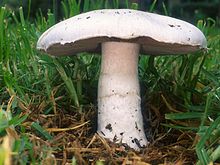| Agaricales Temporal range: Upper Aptian–Holocene,
| |
|---|---|

| |
| Agaricus campestris (field mushroom) (Agaricaceae) | |
| Scientific classification | |
| Domain: | Eukaryota |
| Kingdom: | Fungi |
| Division: | Basidiomycota |
| Class: | Agaricomycetes |
| Subclass: | Agaricomycetidae |
| Order: | Agaricales Underw. (1899)[2] |
| Subdivisions | |
| Synonyms[3] | |
|
Amanitales Jülich (1981) | |
The Agaricales are an order of fungi in the division Basidiomycota. As originally conceived, the order contained all the agarics (gilled mushrooms), but subsequent research has shown that not all agarics are closely related and some belong in other orders, such as the Russulales and Boletales. Conversely, DNA research has also shown that many non-agarics, including some of the clavarioid fungi (clubs and corals) and gasteroid fungi (puffballs and false truffles) belong within the Agaricales. The order has 46 extant families, more than 400 genera, and over 25,000 described species,[4] along with six extinct genera known only from the fossil record.[5][6][1] Species in the Agaricales range from the familiar Agaricus bisporus (cultivated mushroom) and the deadly Amanita virosa (destroying angel) to the coral-like Clavaria zollingeri (violet coral) and bracket-like Fistulina hepatica (beefsteak fungus).
- ^ a b Heads, Sam W.; Miller, Andrew N.; Crane, J. Leland; Thomas, M. Jared; Ruffatto, Danielle M.; Methven, Andrew S.; Raudabaugh, Daniel B.; Wang, Yinan (2017). "The oldest fossil mushroom". PLOS ONE. 12 (6): e0178327. Bibcode:2017PLoSO..1278327H. doi:10.1371/journal.pone.0178327. PMC 5462346. PMID 28591180.
- ^ Cite error: The named reference
Underwood1899was invoked but never defined (see the help page). - ^ Cite error: The named reference
urlMycoBank: Agaricaleswas invoked but never defined (see the help page). - ^ Cite error: The named reference
CatofLifewas invoked but never defined (see the help page). - ^ Cite error: The named reference
Poinar2007was invoked but never defined (see the help page). - ^ Cite error: The named reference
Hibbett2003was invoked but never defined (see the help page).